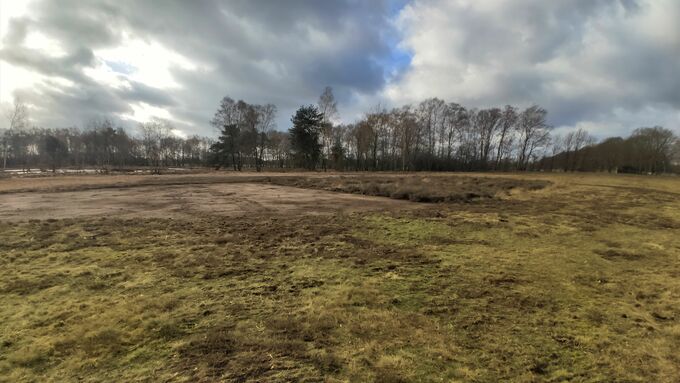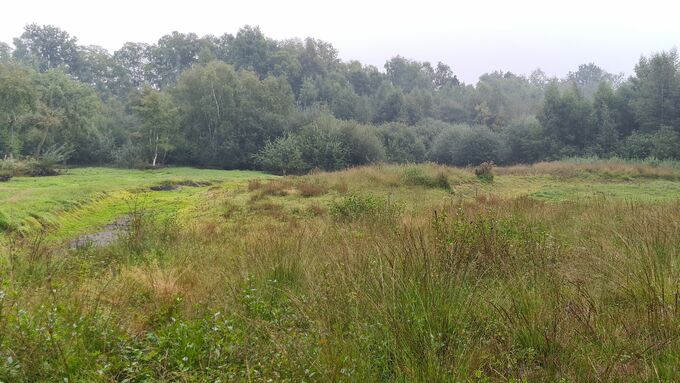The orchid meadow adjacent to the area worked by the LIFE IP was optimised by the District of Borken on its own initiative. Without the LIFE IP measures, this would not have been done to this extent. © Patrick Lücke, District of Borken
main content
Project of the month
# 7/2021 EPER-GRAESER VENN (District of Borken)
Restoration of heath areas in the Special Area of Conservation
The SAC Eper-Graeser Venn/Lasterfeld (DE-3808-301) is located between the northern district of Ahaus, Graes, and Epe, the southern district of Gronau. With a size of about 210 hectares, it is part of the nearly 367-hectare nature reserve Eper-Graeser Venn (BOR-009) which was designated in 1988. The protected area is made up of two well-preserved remnants of the former heath-moor landscape of the Westmünsterland: the Eper Venn on the north-eastern edge and the Graeser Venn on the south-western edge. The complex includes raised and transitional bog areas, dwarf shrub and wet heath areas and a larger heath pond. The area is interlocked with structurally rich wet grassland areas, which are structured by vegetation-rich ditches and rows of copses. Originally, the protected area had been designated because of its importance for ground-nesting meadow birds such as the lapwing (Vanellus vanellus), the curlew (Numenius arquata) and the black-tailed godwit (Limosa limosa), but also little grebe (Tachybaptus ruficollis) and water rail (Rallus aquaticus). A large number of rare and endangered plant species, such as the floating water-plantain (Luronium natans), also find a habitat at the numerous constructed standing waterbodies. Individual waterbodies play an important role as spawning grounds for amphibians such as the crested newt (Triturus cristatus), the European tree frog (Hyla arborea) and the moor frog (Rana arvalis). Together with the neighbouring sub-areas of the SPA ‘Moore und Heiden des westlichen Münsterlandes‘ (DE-3807-401), the Eper-Graeser Venn is a central component of the state-wide and international biotope network with the nearby fen and marsh areas of the eastern Netherlands.
In the framework of the LIFE IP Atlantic Region DE, an area in the east of the SAC was optimised in October and November 2020 in cooperation with the Biological Station Zwillbrock and the Lower Nature Conservation Authority of the District of Borken. The area of this action is partly owned by the district of Borken and partly by the state of North Rhine-Westphalia. The areas are located in the middle of a larger secondary heath complex and were heavily overgrown before the measures began. Before the start of the project, in 2016, measures had already been implemented as part of the Hotspot 22 project ‘Paths to Diversity - Lifelines on Sand’, in which mainly waterbodies and edges had been cleared and dredged. This strengthened the population of the floating water-plantain.
With the works of the LIFE IP, larger areas for the habitat type 4010 and smaller areas of the habitat type 7140 and 3130 have now been restored. In total, an area of 1.6 hectares was cleared. The heath pond was partially desludged and 120 cubic metres of soil were removed for this purpose. Since intact wet heath (habitat type 4010) occurs on the adjacent areas, it can be assumed that this habitat type will also appear on the processed areas. In addition, the habitat for the moor frog, the crested newt, the tree frog and the floating water-plantain was optimised.
The District of Borken continued the works on its own initiative in the meadow adjacent to the LIFE IP action area to the north. According to the measure concept (MAKO), this area is a heath area with habitat types 4010 and 4030 with occurrences of the heath spotted orchid (Dactylorhiza maculata). The entire area is under heavy pressure of woody growth, so that it is mown once a year after the flowering of the marsh gentian (Gentiana pneumonanthe). The removal of further woody plants, the partial sod removal of the overaged Calluna heath and the clearing of emerging woody plants in the remaining Calluna area would not have been implemented to this extent without the LIFE IP measures in the southern area.
Related Topics
- Habitat type 4010
- Habitat type 7140
- Species profile floating water-plantain (Luronium natans)
- Species profile moor frog (Rana arvalis)
Further links
- Nature reserve ‘Eper-Graeser Venn’ – Landesamt für Natur und Umweltschutz (in German) (external link opens in a new window)
- SAC ‘Eper-Graeser Venn/ Lasterfeld’ (DE-3808-301) – Landesamt für Natur und Umweltschutz (in German) (external link opens in a new window)
- Biological Station Zwillbrock (in German) (external link opens in a new window)
- District of Borken - Nature and Landscape Reserves (in German) (external link opens in a new window)
- Hotspot 22: Paths to Diversity - Lifelines on Sand (District of Steinfurt - Nature and Landscape, in German) (external link opens in a new window)





